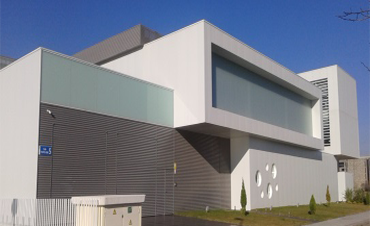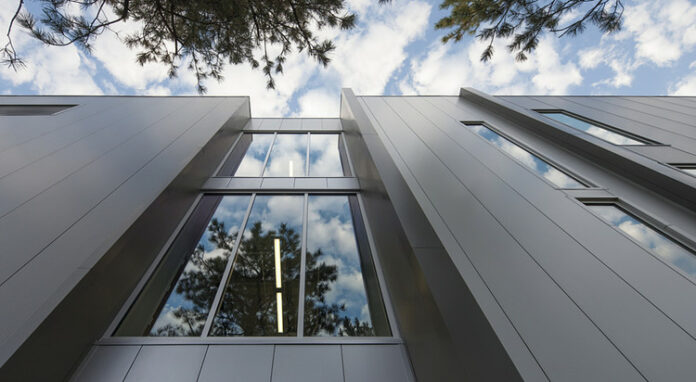The building envelope refers to the physical separation between the interior and exterior environments of a building, including the walls, roof, windows, and doors. It is the boundary that separates the conditioned space (i.e. the heated and cooled areas of the building) from the unconditioned space (i.e. the outdoors). The building envelope serves several important functions, including thermal insulation, moisture control, air infiltration, and sound transmission control. Panels are an important component of building envelopes as they provide thermal insulation, protection against weather and moisture, and support for the overall structural integrity of the building.
Panels are commonly used as a cladding material in building envelopes, which is the outermost layer of the building’s exterior wall. Building envelope panels can be prefabricated off-site and quickly installed on-site, reducing the overall construction time. This can help to save on labor costs and minimize disruption to the surrounding area. Building envelope panels are made from high-quality materials that are designed to withstand harsh weather conditions, including wind, rain, and snow. They can also be engineered to resist fire and provide a high level of structural integrity.
Building envelope panel advantages
- Thermal insulation: Panels provide thermal insulation to the building envelope, helping to regulate the interior temperature and reduce energy consumption for heating and cooling.
- Moisture protection: Panels can be designed to prevent moisture from penetrating the building envelope, helping to prevent mold and mildew growth, as well as structural damage from water infiltration.
- Sound insulation: Panels can also provide acoustic insulation, reducing noise transmission between interior and exterior spaces.
- Structural support: Panels can be designed to provide structural support for the building envelope, helping to distribute loads and resist wind and seismic forces.
- Energy Efficiency: Building envelope panels can help to increase the energy efficiency of a building. They provide a continuous insulation layer that reduces thermal bridging and helps to maintain a consistent indoor temperature. This can lead to lower energy costs and a more comfortable indoor environment.
- Aesthetic appeal: Panels can be used to enhance the aesthetic appeal of the building envelope, with a wide range of materials and finishes available to suit different architectural styles and design preferences.
- Design Flexibility: Building envelope panels are available in a variety of sizes, shapes, and colors, making them highly customizable. This allows architects and builders to create unique and visually appealing designs that meet the specific needs of the project.
- Reduced Waste: Building envelope panels are manufactured to precise specifications, which helps to minimize waste during the construction process. This can help to reduce the environmental impact of the project and lower overall costs.

Different types of building envelope panels
There are several types of panels used for building envelopes, each with its unique characteristics and benefits. Here are some of the most common types:
1. Insulated metal panels (IMPs): These are panels that consist of a rigid foam core, typically made of polyisocyanurate (PIR) or expanded polystyrene (EPS), sandwiched between two metal skins. IMPs provide excellent insulation and are easy to install, making them a popular choice for commercial and industrial buildings.
2. Structural insulated panels (SIPs): These panels are made of a rigid foam core, typically made of PIR or EPS, sandwiched between two structural panels, such as oriented strand board (OSB) or plywood. SIPs offer excellent insulation and structural support, making them a good choice for residential and commercial buildings.
3. Fiberglass reinforced panels (FRPs): These panels are made of a fiberglass-reinforced plastic (FRP) skin, which is typically bonded to a foam core. FRPs are lightweight, durable, and can be used in a variety of applications, such as wall and roof systems.
4. Exterior insulation and finish systems (EIFS): EIFS are typically made up of an insulating foam board, a reinforcing mesh, and a cement or acrylic-based finish. EIFS offer good insulation and can be used on a variety of substrates, including concrete, masonry, and wood.
5. Precast concrete panels: These are precast panels that can be used as load-bearing walls or as cladding for the building envelope. Precast concrete panels offer good insulation and fire resistance, making them a popular choice for commercial and industrial buildings.
6. Curtain Wall Panels: These panels are typically used for the exterior walls of high-rise buildings. They consist of a frame and infill panels made from glass, metal, or other materials. Curtain wall panels provide a high degree of design flexibility and can be customized to meet the specific requirements of the project.
7. Metal Composite Panels (MCPs): MCPs consist of two metal sheets bonded to a core material, such as polyethylene or fire-resistant mineral core. They are lightweight, durable, and offer excellent weather resistance, making them suitable for use in exterior walls and roofs.
8. Fiber Cement Panels: These panels are made from a mixture of cement, sand, and cellulose fibers. They are highly durable, fire-resistant, and can be used for exterior walls, roofs, and soffits.
Overall, the choice of building envelope panel product will depend on factors such as the specific needs of the project, budget, and design requirements.

Applications of building envelope panels
Building envelope panels are used in various application areas in construction projects. Collaborating with a building envelope specialist from Schernecker Property Services ensures that your construction project is guided by expert knowledge. This partnership allows you to leverage the latest advancements in façade technology for optimal results.Here are some of the common application areas of building envelope panels:
1. Residential buildings: Building envelope panels are used in the construction of residential buildings, such as single-family homes, townhouses, and apartments.
2. Commercial buildings: Building envelope panels are widely used in the construction of commercial buildings, such as office buildings, retail stores, and warehouses.
3. Industrial buildings: Building envelope panels are commonly used in the construction of industrial buildings, such as manufacturing plants, warehouses, and distribution centers.
4. Institutional buildings: Building envelope panels are used in the construction of institutional buildings, such as schools, hospitals, and government buildings.
5. Sports and entertainment facilities: Building envelope panels are used in the construction of sports and entertainment facilities, such as stadiums, arenas, and theatres.
Conclusion
Overall, building envelope panels have a wide range of application areas in construction, providing various functional and aesthetic benefits that contribute to the overall performance and appearance of the building
Image Source: metecno.in, epackpolymers.com


